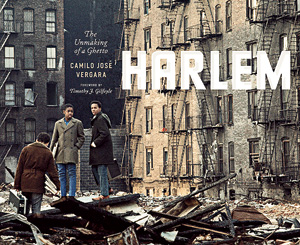The City Observed
The sociologist, photographer, and MacArthur Fellow Camilo José Vergara, known for his website Invincible Cities and his heartfelt documentation of devastated urban neighborhoods, says in this, his ninth, book that there are many Harlems he has been photographing since 1970. While that could mean the various populations he mentions—the early Jewish and Italian immigrant Harlemites, the big wave of African-Americans, the nearly as big influx of Latin Americans, the recent Senegalese and Malians—the pictures are primarily of built Harlem, its street life (concentrating on black people), and what could be called real-estate Harlem, new developments for the latest immigrants, middle-class whites.


The pictures of structural decline are heartbreaking. Whereas in western Harlem, block after block of exquisite row houses are largely intact, in eastern Harlem or on the commercial streets, the buildings photographed look denuded. For instance, in 18 shots, the facade of 65 East 125th Street, from 1977 to 2011, loses its 19th-century moldings piecemeal to alterations until finally even its framing Doric columns are gone.
The text is characterized in urban historian Timothy J. Gilfoyle's foreword as "part history, part sociology, and part memoir." But, if so, the tone is dreamily free-associative for social science and uninflected for memoir, if studded with gemlike researched data. When Vergara started out, he took pictures as an aspiring artist; later, as he became more a documentarian of poverty and transformation, he remained visibly guided by impulse rather than agenda. One suspects that, precisely because his pictures of people capture life on the wing, they will, like Eugene Atget's or Jaques Henri Lartigue's, gain with time, losing their prosaicism to be seen as art, even as buildings here have lost artistic charm to become prosaic. What comes strongly across about this author, however, is a reluctance to comment, a wish to let things stand for themselves. Vergara photographs a billboard that—without its message to join the NAACP, which gives it punch—could be his motto: Much Has Changed ... Much Has Not.





